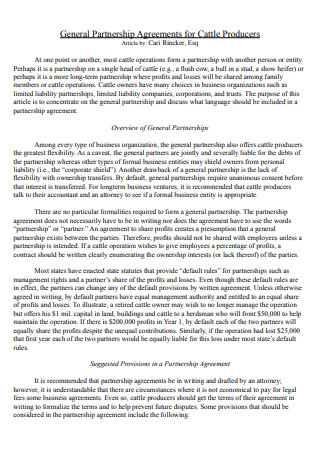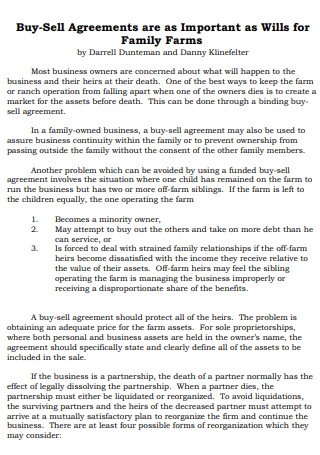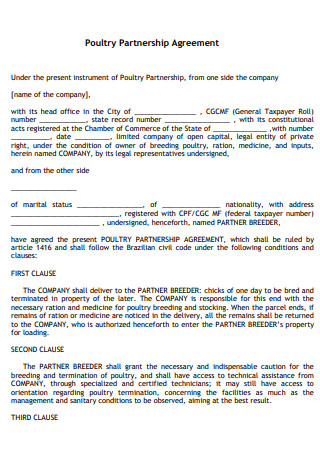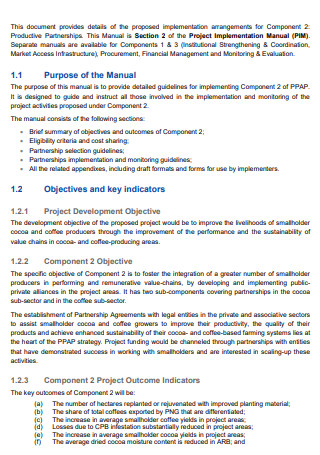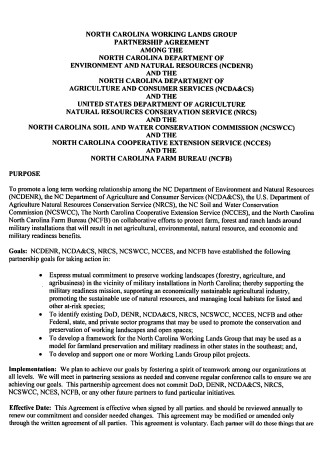5+ SAMPLE Farm Partnership Agreement
FREE Farm Partnership Agreement s to Download
5+ SAMPLE Farm Partnership Agreement
What Is a Farm Partnership Agreement?
What Is a Farm Partnership?
What Are the Aims and Objectives of the Partnership Firm?
What Are the Advantages and Disadvantages of Partnership?
What to Know Before Partnership Registration?
4 Steps in Forming a Farm Partnership:
FAQs
What type of farming is the most profitable?
What crop is in highest demand?
Which vegetable farming is more profitable?
What Is a Farm Partnership Agreement?
A Farm Partnership Agreement appoints the scale of partners’ income tax payments or deductions to the share of their profits or losses. Partners also carry individual liability for gains or losses sustained in the sale of the farm’s fixed assets and facilities. Moreover, the income of a farm partnership is not subject to taxation, because partners are individually liable for the taxes accredited to their income. The partnership only files Form 1065 to report the generated and distributed income or losses.
What Is a Farm Partnership?
A Farm Partnership is when two or more farmers come to an agreement to share resources so they can enjoy benefits such as economies of scale and better work-life balance. Farmers can make use of a number of financial supports aimed at encouraging and maintaining the development of farm partnerships.
While a partnership is a business arrangement where the profits from that business are split among the partners in the partnership, the liability scope of farm partners relies on whether they signed a general partnership or a limited partnership agreement. General partners join in the daily management of the business, while limited partners only contribute capital, such as funds, land, and equipment. In comparison, general partnership extends partners’ responsibilities to their personal properties, limited partnership restricts such responsibilities to properties owned by the farm enterprise.
Since 2002, partnerships have been used as a structure to combine two or more farming businesses into one arrangement, known as inter family partnerships or just between two farm families.
What Are the Aims and Objectives of the Partnership Firm?
A partnership is just like of business where a formal and a legal agreement between two or more people is made to agree to be the co-owners, distribute responsibilities for controlling an organization, and communicate the income or incompetence that the firm creates.
The aims of partnership firms are to turn a profit at maximum level, to optimize revenue from purchases, and if they want to make huge money. While the partnership firm’s goals are: profits to partners, success in the market competition, services of products, and gain more market shares.
What Are the Advantages and Disadvantages of Partnership?
Contemplate a partnership if the number of people involved is small (up to about 20) and limited liability is not essential.
The advantages of a partnership include:
- The business is easy to establish and start-up costs are low
- Two heads (or more) are better than one
- High-caliber employees can be made partners
- More capital is available for the business
- You will have greater borrowing capacity
- There is opportunity for income splitting, an advantage of specific importance due to resultant tax savings
- Partners’ business affairs are private
- It is easy to change your legal structure later if situations change
- There is limited external regulation
The disadvantages of a partnership include:
- The accountability of the partners for the debts of the business is unlimited
- Each partner is ‘jointly and severally’ responsible for the partnership’s debts; which means, each partner is liable for their share of the partnership debts as well as being liable for all the debts
- Each partner is an agent of the partnership and is liable for actions by other partners
- There is a risk of disagreements and friction among partners and management
- If partners join or leave, you will probably have to value all the partnership assets and this can be costly
The general form of partnership is known as intra family partnership, also known as ‘within family’, where the partnership is used as a transition arrangement to slowly introduce a successor to the family farming business.
What to Know Before Partnership Registration?
Business partnerships play a big role in the success of new ventures. They come with an extra managerial support—a blend of skills, intellectual, and monetary capital. Maintaining partnerships is a task since factors like ego, money, conflict can lead to a bigger problem. Before your partnership registration, make sure you are knowledgeable about these:
4 Steps in Forming a Farm Partnership:
The usual form of partnership known as intra family partnership, is where the partnership is used as a transition arrangement to gradually introduce a successor to the family farming business.
Step 1: Setting Up the Partnership Herd Number
The existing herd number or herd numbers—in the case where two separate farms are combining—must be changed into the same name as the partnership and the partnership bank account.
This totally means adding a name or two names to the existing herd number. Changes to a herd number must be done through the local District Veterinary Office (DVO) by completing and submitting one of two forms. It is essential to seek the advice of the local DVO in making changes to the herd number. A note explaining the required changes to the herd number by the partnership set up process should be provided to the DVO.
The forms used are as follows:
An ER1.1 form should be used where names are added to a herd number provided the registration details and herd keeper are not changing.
An ER1 form is required where the herd keeper is changing.
Copies of all ER1 and ER1.1 forms submitted to the DVO should be kept on file along with a date stamp or receipt from the DVO as proof that it was submitted.
When combining two herd numbers, in a case where two herd numbers are being merged into one, a separate ER1.1 form must be filled out for each herd number to change the name on each respective herd number into the partnership name. Where one of these two herd numbers is being made dormant, it is important to instruct the DVO in writing not to ‘End Date’ this herd number.
It is essential to be aware that if changes are made to a herd number after the Basic Payment Scheme application and amendment deadlines, it may cause delays in the receipt of payments in that year.
This should be discussed with the agricultural advisor. The key window for making changes to a herd number is after basic payments have been received for the current year but well in advance of the Basic Payment Scheme Application period for the following year.
Generally, this means changes should be made between December and the end of February the following year to allow ample time for successful processing of the ER1 and ER1.1 forms by the District Veterinary Office.
On the other hand, any changes to the names on a herd number will require a ‘Transfer of Entitlements’ form. If the changes occur before the Basic Payment Scheme deadline, then the transfer form must be submitted before the Basic Payment Scheme deadline.
Step 2: Setting Up the Partnership Bank Account
In the majority of situations, financial institutions or the bank will not allow a name to be added to an existing current account. A new partnership bank account must be set up in the same name as the partnership. This becomes the trading account for the partnership through which all partnership income and expenditure is channeled. It is very important to take ownership of the process of moving bank accounts to ensure that any direct debits or standing orders for utilities or loan repayments are reestablished in the new partnership bank account.
Step 3: Completing the On-Farm Agreement
The on-farm agreement should be completed by the partners and their families as part of setting up the partnership.
A professional help can be used in this document but the daily operation of the partnership is very much the responsibility of the partners. If this aspect is not taken seriously, many of the benefits from its formation such as better lifestyle will not turn into a reality.
Step 4: Completing the Registration Process
The arrangement of the farm partnership and the registration process is usually completed with the help of all of the following professionals or a combination of all three:
- The Agricultural consultant
- The Solicitor
- The Accountant
The roles and responsibilities of these professionals are vital that they need to cooperate and work together in the formation of the partnership to achieve the best result for the farm family.
FAQs
What type of farming is the most profitable?
Although soybeans are the most profitable crop for large farms, fruit trees and berries create the most profit of all farm sizes. As farm size grows, labor costs to tend, and harvest fruit trees and berries become too high to maintain profits.
What crop is in highest demand?
The world’s most valuable cash crop is cannabis, according to an absolute value perspective. It is followed by rice, maize, and then wheat.
Which vegetable farming is more profitable?
Tomato cultivation is one of the most profitable agriculture businesses. Cultivating tomato is an excellent choice for those looking to harvest a commercially important crop in 4 times a year.
Generally, these are some of the essentials a businessman needs to be aware of before thinking about having a farm partnership. These key points can help make better decisions when it comes to the partnership and establish a successful business. Partnerships are great to start out with, however, as one develops, many other business structures can be chosen according to one’s requirements.
A great farm partnership can help build a healthier planet. However, it is important to ensure it is carried out properly, in a way that puts money back into the pockets of the people who grow our food, and most especially, we need to make a system that can scale.
Well-managed farm partnership is an effective way to coordinate and campaign production and marketing in agriculture. Nonetheless, it is crucially an agreement between unequal parties: companies, government bodies, or individual entrepreneurs on the one hand and economically weaker farmers on the other. It is, however, an approach that can give to both increased income for farmers and higher profitability for sponsors. When effectively organized, controlled, and managed, farm partnership lessens risk and uncertainty for both parties as compared to buying and selling crops on the open market.

